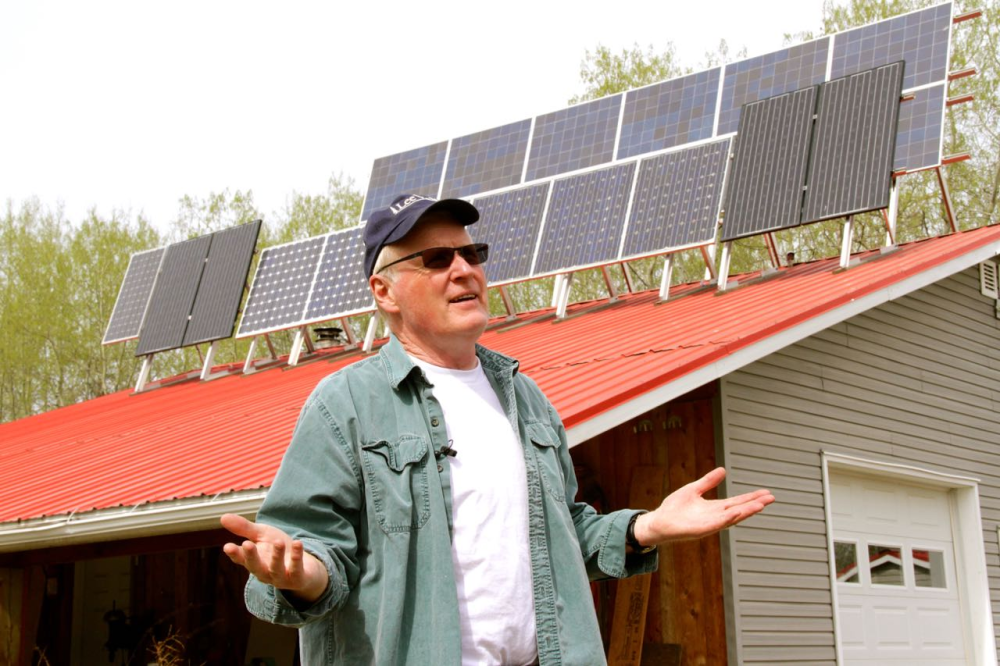On a crisp spring morning, a pair of Canada geese lift off and glide low over Nakamun Lake. The beating of their wings breaks the still waters which ripple with reflections of pink clouds, hovering low in the predawn air.

An hour northwest of Edmonton, Alberta, Bob Chelmick rises from a chair on the east-facing porch of his solar-powered cabin in the woods to greet me.
“Can I get you some tea?” Bob asks as SonnyBoy, a golden rescue dog and Samantha, a foundling black dog left at the local Nakamun Superette, bound to greet us.
A veteran broadcaster, photographer and artist, Chelmick is the producer of The Road Home, one of the most innovative radio programs on air today.
Chelmick calls it “extra-ordinary radio” and it surely is. You could call it spoken word radio, but that doesn’t quite do it justice.
“I hesitate to use the P-word, but I'm going to,” says Chelmick. “For people who haven't heard The Road Home and who have been brought up in normal schooling, poetry is a nasty word. I discovered the beauty of poetry when I was a teenager and started reading it and exploring it that way. I've always wanted to integrate it on radio, because when it's presented as an oral art form, it really sings.”
To be clear—this is not a poetry show, at least not in the way you might think. It’s about stories of home, Bob’s cabin in the woods, his dogs, horses and the boreal forest. It’s a journey home for the dedicated fans who love and live in the show for the two hours it’s broadcast on Sundays at 8 p.m. on CKUA Radio. It’s a home for modern poetry wrapped in story, music and Chelmick’s silky smooth baritone voice.
A renaissance man, Chelmick is known to many as a former news anchor for CBC or CTV. But he is also an accomplished photographer, the former morning host of CKUA Radio in Alberta and a lifelong student of poetry.
Coming home from the bright lights of news “infotainment”

As a young man, Chelmick dreamt of being a forester; he performed in a folk band, drove a Datsun 240Z and had “long hippie-ish hair.” After studying Radio and Television Arts at NAIT in Edmonton, he got a taste of his future at CKUA Radio, before starting his career as a news anchor. But one day, 20 years into his sterling news career, he had an epiphany.
"Television is crap! What is it? Infotainment? I just, I had to get out of it,” says Chelmick. He hasn’t owned a TV since.
“When I came back to CKUA, 1999 I think it was…” says Chelmick. “I felt like I was coming home to community radio that wasn't focused on the mighty dollar. I loved that and it was authentic. You could be authentic on the radio.”
Though Chelmick was a very popular morning man at CKUA, it wasn’t long before he starting formulating an idea for his next adventure.
What came first: The cabin or The Road Home?

Chelmick’s solar-powered cabin in the woods was “an escape. By day, the bright lights, the studio, the news, all that stuff. By weekend, the calming quiet of the country.”
After a long search, Chelmick purchased a quarter section of forested land near Nakamun Lake, about one hour northwest of Edmonton, Alberta.
His new getaway required the hard work of clearing brush and laying a foundation. The original cabin was 600 square feet and solar-powered complete with battery storage. Why solar? Chelmick recalls seeing brown streaks across the sky near Lake Wabamun.
“It was from coal-fired generation at Wabamun, and it really was disturbing to me” says Chelmick. “It would stretch as far as the eye could see, this brown haze. I didn't want to be part of that. I didn't want to buy into it literally or figuratively.”
“Another consideration was purely economic. I'm about half a mile from the power line and so that was costly. Back then, they quoted me about 15 or 16 grand to put power in here.”
Solar-powered Cabin in the Woods
Chelmick started small, with an 80-watt solar module, powering the fan in his composting toilet. Solar was much more expensive then. Over the years the system was expanded several times. Today, it’s 3.4 kilowatts.

Ten years after adding the battery storage system, Bob faced a dilemma. It was going to cost $10,000 to replace the batteries, so he decided to bite the bullet and hook up to the grid and use it as his virtual battery instead. Luckily, the utilities have changed their approach and it was a much cheaper today than it once was.
As for his storied Cabin in Woods, Chelmick had done research into straw bale construction, EarthShips, cob and even cord wood masonry construction. But eventually he settled on “stick construction and good insulation.” When the time came for additions, Chelmick used “double-wall construction, two by six and two by four, with rigid insulation between them.”
The cabin has a natural gas furnace, but a wood stove provides most of the heat, from wood harvested by Chelmick just outside the cabin’s door.
It was from this place in “the calming quiet of the country” that The Road Home was born.
The Road Home, solar-powered radio
“When I came with the title of the program, The Road Home, and put the proposition forward to CKUA, I thought of Sunday nights coming back from the lake after a summer weekend—it's kind of a magic time, you're weary and you're looking forward to getting back into your life,” says Chelmick.

“I wanted to integrate the things I love in my life most. Living here in a cabin, living out of the city, living in nature, making radio, storytelling, and painting pictures through that storytelling.”
“The best pictures I make are on radio,” says Chelmick, an accomplished and exhibited photographer.
Oh, and poetry: “I think poetry belongs on radio. It's not the rhyming poetry of our fathers and grandfathers. It’s free verse, which is I think very powerful and beautiful. It has an aesthetic. The Road Home has an aesthetic, that's for sure, that's based on its poetry and its mix of music,” says Chelmick.
If you haven’t heard The Road Home, you can on CKUA Radio or at roadhome.FM, Chelmick’s own streaming radio service.
Listening to one episode of The Road Home, wood frogs from Bob’s pond sing in the background and take me to my childhood home in north Edmonton where boreal chorus frogs and wood frogs greeted me every spring just outside my bedroom window.
The Road Home is much more than a destination. “Don't be looking to get somewhere without enjoying the process of getting there, the road home is home,” Chelmick says paraphrasing 13th century Persian Sufi mystic Jalāl ad-Dīn Rūmī, who provides the best description of Chelmick’s show.
“People say, they live vicariously through The Road Home, so they have this little oasis, their little cabin in the virtual woods through this radio program. And I love that.”
What about the “P” word?
The Road Home is a multilayered weaving of story, music, nature, the cabin-in-the-woods and yes, poetry. Friends advised Chelmick to be “careful with the ‘P’ word, just call it spoken word” radio, they suggested.
But Chelmick is an unabashed evangelist of poetry and proselytizer of his favourites, including Mary Oliver and Lorna Crozier, who, like Chelmick, take inspiration from the natural world.
“The people I relate to who write poetry, [are those] who tell stories from their environment, which is similar to my environment, and do it so well, they're so inspiring,” says Chelmick.
In a way he’s right. The Road Home is not a poetry show per se. It’s a soothing, intricate blend of storytelling woven together with inspiring music, the sounds of nature and yes, poetry all wrapped in a peaceful sense of place. A place we can all call home.
You can hear The Road Home live on the CKUA Radio Network or listen anytime at roadhome.fm.











